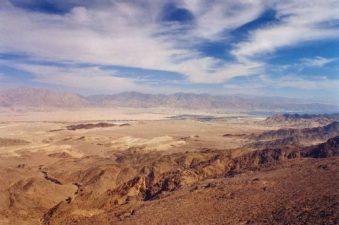 You see all kinds of weird transportation in the Middle East: but the worst is drifting where young Arab males purposefully “drift” their cars into crowds of people.
You see all kinds of weird transportation in the Middle East: but the worst is drifting where young Arab males purposefully “drift” their cars into crowds of people.
I don’t understand the lust for cars. I’m unresponsive to the siren call of Formula 1, NASCAR, and Top Gear. I think commuter trains and subways are the greatest invention since – well – the wheel. So, last week, I shrugged off reports that the Grand Mufti of Dubai proclaimed it a sin to violate traffic rules. No worries for this straphanger. My soul keeps its new car smell.
In other Gulf news, a young Saudi was sentenced to 150 lashes for “drifting” his car after police repeatedly caught him driving like a maniac. Police Director Maj Yehya Al-Biladi urges young men to abstain from drifting, and guarantees severe penalties for future offenders. He told ArabianBusiness it was a “completely wrong” concept that Islam discourages seat belts “as safety is in God’s hand.”
Most drivers drift in Jordan, where road markings are viewed as subtle invitations to stay in your lane. If lashings were doled out on reckless drivers here, there would be a market run on cat-o-nines.
Want a primer in how to drive in Amman? Glue a cell phone to your ear; plunk multiple babies on the lap of your front seat passenger; and maybe load some livestock in back.
Seatbelt, what seatbelt? Never signal when switching lanes; only chumps check if another car is already in that spot you want. Those last bits pretty much sum up “drifting”, right?
The 20-somethings in my office set me straight. Drifting in the Kingdom of Saudi Arabia (KSA) is a misnomer. It’s purposeful, high speed skidding. It makes Jordan’s lateral glide look like geriatric Fred Astaire.
KSA drifting is an informal sport where drivers intentionally over-steer (read our previous story on drifting in Saudi Arabia) losing traction and spinning out wildly across the road, often onto the pavement, frequently slamming into buildings and spectators.
Yup, spectators.
In this kingdom where most idle pastimes are ruled illegal or immoral, young men use social networking to communicate where the daily drifting will occur. They flock to the sidelines of highways to watch the imbecilic Olympics.
YouTube offers loads of near-miss drifting; idiotic daredevils reenacting their favorite Grand Theft Auto getaway.
[youtube]http://www.youtube.com/watch?v=Kk3ZS6NRiHA&feature=related[/youtube]
My office guys, young Jordanians who are frequently in KSA, tell amazing stories. One saw a guy driving through Jeddah using only his two passenger-side wheels. The two watched a car arabesque off an overpass onto a poultry-filled truck. Another drove into a light pole to avoid getting sideswiped by a runaway drifter.
There’s nothing for Saudi young men to do with their time, they tell me. The intense climate takes most sports off the entertainment menu. Young men are typically underemployed. Most salaries can’t compete with generous government stipends given to all residents, so there’s little incentive to get a real job.
KSA social life revolves around faith and family and home. There’s no casual mingling with the opposite sex. The classic combination of youthful rebellion and fast cars is an intoxicating alternative. Green Prophet has reported that the burgeoning fast food boom intends to fill a social gap for KSA youth. Crashing cars is an equally unhealthy option.
Saudi women are banned from driving; young men learn to drive in ad hoc fashion. There’s no “driver’s education” in secondary schools, and the wealthy employ personal drivers (no driveway lessons from mom and dad). Traffic violations are loosely enforced. Luckily, drunk driving is virtually nonexistent, but the same can’t be said for driving under the influence of illegal drugs.
An MSN Cars survey based on 2007 statistics, counted six Middle Eastern nations among the ten most dangerous countries to drive in. Libya, Afghanistan, Iraq can blame war. Saudi Arabia, the United Arab Emirates, and Egypt can’t share that excuse.
The World Health Organization found Saudi Arabia to lead the world in highest number of road accident deaths, now the principal cause of death in Saudi males aged 16 to 36. The UAE spends almost $1.5 billion on road-related accidents each year.
A special raceway was built in Jeddah, meant to attract drifters to the track instead of the streets, but apparently these guys prefer to remain Bedouin urban cowboys.
In a rapidly shrinking world, it’s startling to see residual evidence of strikingly different cultures. To westerners, 150 lashes seems extreme. To a pacifist like me, its abhorrent.
Rich, bored and spoiled young men have the financial means to fix the wreckage of their actions with money. With lashings looming, perhaps they’ll think twice.
Image of camels in truck by Laurie Balbo




Arab drivers (young) dont care who else is on the road.
They are bilnded to other traffic and real people who are just trying to get from a to b safely.
Gulf has one of the highest death rates per 100,000 the statement by police that “it was a “completely wrong” concept that Islam discourages seat belts “as safety is in God’s hand.” stuck the nail to the root cause of problem, Laisser-faire policy by most ppl. We had started Suraya foundation back in 2010 and found high authorities are themselves to blame for the misconception.This slow change is positive though they have long way to go.
I hear that UAE and/or other Gulf states give a ‘salary’ to every citizen, but I don’t have any real facts to back it up. Sorry.
I must say I am enjoying your posts.
Would you know how the KSA program compares to other gulf nations?
More or less generous than UAE as example?
Always interesting to see how others tackle social welfare.
Thanks again for your comment.
“I based the “stipend” statement on info provided by a Royal Jordanian human resources contact, who stated that unemployed Saudis receive 3000 Saudi riyals per month.”
That information is not quite the way it is made to sound. There are strict regulations attached to the stipend (which is only 2,000 Saudi riyals) and is not given indefinitely. It is more like a welfare program. It is only given only for a period of two years during which the recipient must be actively looking for a job, must attend training courses and must accept the job provided for him/her by the employment offices. If the recipient does not attend the training or show up for the job provided, (s)he will be expected to pay back the amount of money they have received – to prevent the no-show jobs, perhaps?
I based the “stipend” statement on info provided by a Royal Jordanian human resources contact, who stated that unemployed Saudis receive 3000 Saudi riyals per month. That approximates 570 JD which is what a professional engineer with 3-5 yrs experience will earn in Amman. I understand this payment has been increased (as have civil service salaries) in the aftermath of the Tunisian and Egyptian uprisings.
http://www.voanews.com/english/news/middle-east/Saudi-King-Promises-Reform-Offers-Cash-to-Residents—118235969.html
In Jordan, there’s widespread belief that the program of Saudization has fostered creation of no-show jobs in KSA.
Sour grapes perhaps from a nation envious of it’s oil-rich neighbor. I’d like to write an article that contradicts these assumptions, but as you point out – it needs to be based on facts.
Thanks for the great comments.
You need to check on a few facts:
“Most salaries can’t compete with generous government stipends given to all residents, so there’s little incentive to get a real job.” What government stipends????? Where did that idea come from?
“the wealthy employ personal drivers” – since the women can’t drive, almost every family has a personal driver, not just the wealthy.